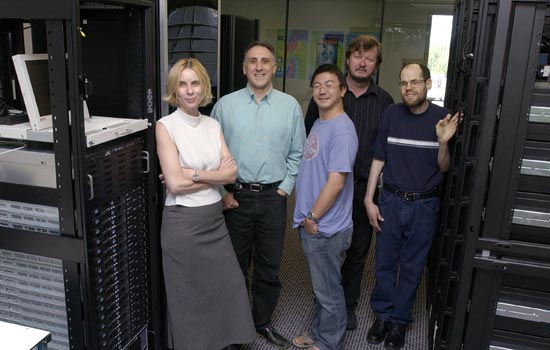Advanced computer cluster powers RIT astrophysics research
A. Sue Weisler | photographer
Members of the Center for Computational Relativity and Gravitation include, from left to right, Manuela Campanelli, Carlos Lousto, Hiroyuki Nakano, Hans-Peter Bischoff and Yosef Zlochower.
When black holes crash into each other at the center of a galaxy, the safest place to be is on the other side of the computer simulating the drama. Scientists who study black holes simulate cataclysmic collisions on supercomputers that work around the clock churning out computations that would sizzle the latest desktop model.
RIT’s Center for Computational Relativity and Gravitation recently won $330,000 from the National Science Foundation to build a new computer cluster that will maintain the center’s competitive level of research in computational astrophysics and numerical relativity, a research field dedicated to proving Einstein’s theory of general relativity. RIT scientist Manuela Campanelli leads the research center and the team that, in 2005, solved the 10 equations in Einstein’s theory of general relativity for strong field gravity—a discovery made possible through advances in computer technology and the team’s fresh approach to the problem.
Now, Campanelli’s team is building a computer cluster to remain at the forefront of their field. The computer, named “newHorizons,” will make the Center for Computational Relativity and Gravitation host to one of the largest computing facilities in the region. “The new cluster will be the main work horse of the center,” says Campanelli, associate professor in the School for Mathematical Sciences. “It will give us the ability to do more refined simulations. It will also allow students to be able to work with us on projects.” The computer cluster is a special-purpose machine designed with the best technology available, says Carlos Lousto, associate professor in RIT’s School for Mathematical Sciences. “The kinds of computations we do are different, new,” he says. “Before simulations can advance to the next level, all components of the computer must communicate.” Lousto designed and built the computer using hardware from California-based Western Scientific.
The 85 nodes that make this computer “super” each has its own dual processor, or four amounts of computing units per node. Direct communication between the nodes is made possible by AMD processors, allowing for high-speed interconnections called HTX or hyper thread connections. Another unusual characteristic is that each node has 16 gigabytes of memory or a total of 1.4 terabytes of memory. In addition, infinite band technology makes the RIT supercomputer especially fast, moving “packages” of information with a lag time or latency of 2.9-microseconds—the fastest rate possible. Node-by-node, the new supercomputer at RIT outperforms the computers at the national labs, Lousto says.









